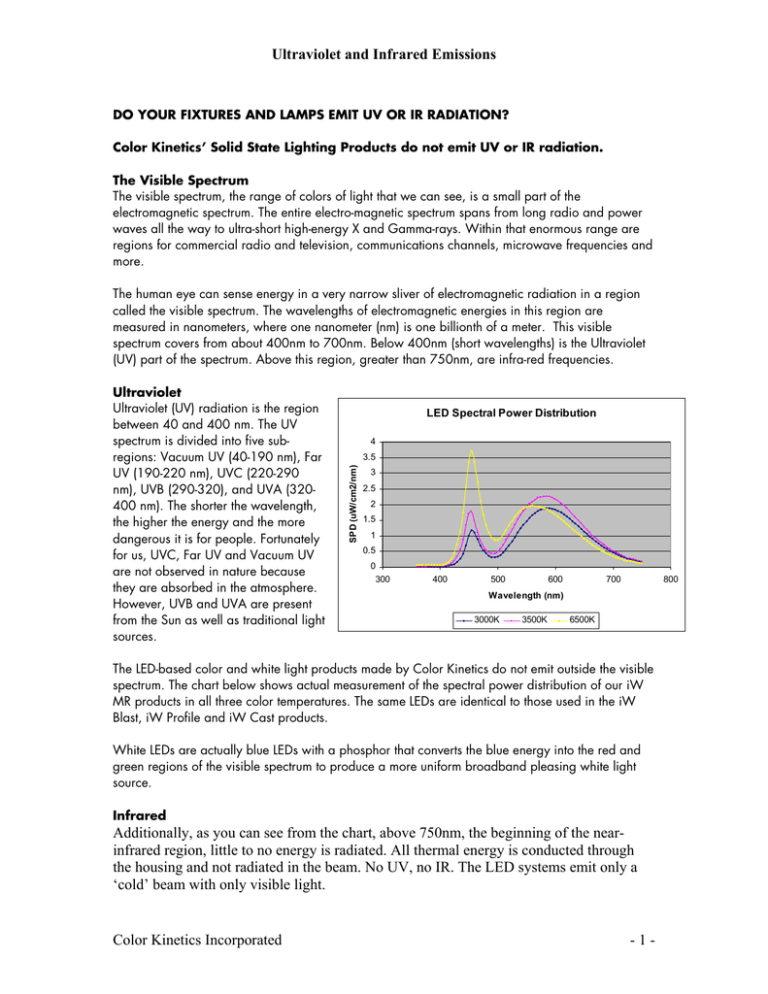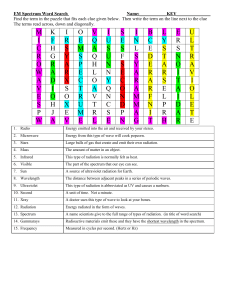Ultraviolet and Infrared Emissions Color Kinetics Incorporated
advertisement

Ultraviolet and Infrared Emissions DO YOUR FIXTURES AND LAMPS EMIT UV OR IR RADIATION? Color Kinetics’ Solid State Lighting Products do not emit UV or IR radiation. The Visible Spectrum The visible spectrum, the range of colors of light that we can see, is a small part of the electromagnetic spectrum. The entire electro-magnetic spectrum spans from long radio and power waves all the way to ultra-short high-energy X and Gamma-rays. Within that enormous range are regions for commercial radio and television, communications channels, microwave frequencies and more. The human eye can sense energy in a very narrow sliver of electromagnetic radiation in a region called the visible spectrum. The wavelengths of electromagnetic energies in this region are measured in nanometers, where one nanometer (nm) is one billionth of a meter. This visible spectrum covers from about 400nm to 700nm. Below 400nm (short wavelengths) is the Ultraviolet (UV) part of the spectrum. Above this region, greater than 750nm, are infra-red frequencies. LED Spectral Power Distribution 4 3.5 SPD (uW/cm2/nm) Ultraviolet Ultraviolet (UV) radiation is the region between 40 and 400 nm. The UV spectrum is divided into five subregions: Vacuum UV (40-190 nm), Far UV (190-220 nm), UVC (220-290 nm), UVB (290-320), and UVA (320400 nm). The shorter the wavelength, the higher the energy and the more dangerous it is for people. Fortunately for us, UVC, Far UV and Vacuum UV are not observed in nature because they are absorbed in the atmosphere. However, UVB and UVA are present from the Sun as well as traditional light sources. 3 2.5 2 1.5 1 0.5 0 300 400 500 600 700 800 Wavelength (nm) 3000K 3500K 6500K The LED-based color and white light products made by Color Kinetics do not emit outside the visible spectrum. The chart below shows actual measurement of the spectral power distribution of our iW MR products in all three color temperatures. The same LEDs are identical to those used in the iW Blast, iW Profile and iW Cast products. White LEDs are actually blue LEDs with a phosphor that converts the blue energy into the red and green regions of the visible spectrum to produce a more uniform broadband pleasing white light source. Infrared Additionally, as you can see from the chart, above 750nm, the beginning of the nearinfrared region, little to no energy is radiated. All thermal energy is conducted through the housing and not radiated in the beam. No UV, no IR. The LED systems emit only a ‘cold’ beam with only visible light. Color Kinetics Incorporated -1-



